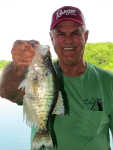- Missouri campgrounds resurgence (5/30/20)
- August a fantastic month for catfishing (8/11/18)
- Kayaking, canoeing good way to spend hot summer days (7/27/18)
- Hot weather means hot catfishing (7/7/18)
- Boat buyers have abundant options (6/16/18)
- Warm weather invites camping (6/9/18)
- Topwater fishing is a blast (6/2/18)
Modern innovations not always embraced by fishing world
Saturday, June 6, 2015

Submitted photo/
Jim Walker, Springfield, displays a big crappie he caught while fishing on Stockton Lake. He recalled how far fishing has come since his early days of fishing.
Nevada Daily Mail
After watching a Bassmasters tournament weigh-in, some onlookers were in agreement that the fishing world had really changed from the days when you would take a cane pole with a can of worms and head for the river or lake.
Modern technology has given anglers a wide selection of sophisticated gear to help find fish fast. Ultralight reels and rods help detect hits more easily. We have better boats and motors than ever before, lines that are all but invisible and lures that closely look like the real thing. Even hooks and sinkers are much improved than they were just a few years ago.
In a recent conversation with Jim Walker, Springfield, he recalled in his early days of fishing, a 50 horse outboard motor would make the owner the king of the waterway and an angler used a stringer since most fishing boats didn't have a livewell.
He said, "I recall losing fish that were on my stringer when a log would snag the stringer and I would lose the fish that were on it. There were times when a turtle would sneak up and dine on the stringer hanging over the side of the boat. Things have really changed and for the most part the change has been good."
Our lakes and streams hold more game fish than ever before and the thousands of ponds have turned farm land into some of the best fishing in the state. Our native fish have been enhanced along with new species that have been introduced to Missouri waters including striped bass and muskies.
Despite all these modern innovations of new species, equipment and more water to fish, a lot of anglers aren't broadening their fishing habits.
Instead, they continue to fish the same waters the same way they always have and if their favorite methods don't work, they go home skunked. It's no wonder the old saying, "10 percent of the fishermen catch 90 percent of the fish," holds true.
Versatility is the secret to becoming a better angler. There are a lot of factors that influence where fish are found, what they want and the mood they are in. An angler must be prepared to reach into his bag of tricks and come up with the technique that is best suited to the conditions of the day. It also helps to have confidence in the selected strategy.
To be a better angler, it is important to know how the fish operate. The fish are fine-tuned to their watery world. They have the same senses as other animals: sight, hearing, taste, smell and touch. They also have the lateral line that enables them to find food and detect danger even when they can't see.
Like the angler, fish see color and brightness. Shallow water fish have excellent vision like the largemouth bass that can detect most colors. However, some fish including walleye can't see the full range of color. Walleye see only orange and green while other colors appear as shades of gray.
Many times to change of color of lure can mean the difference in catching fish or going home empty handed.
Cover is another important item for anglers to learn as fish do. From the day the fish hatch as fry they are tested in their ability to survive. They discover the need for cover at an early age.
Even with cover, nature will take a heavy toll. Some fish lay as many as 100,000 eggs. Less than a half may hatch and of those, only a few may reach adulthood.
Cover can be anything from weeds to rocks. Some cover offers the fish nothing but shade including overhanging trees. Even so, these places are important for light-sensitive species including bass and walleye.
Finally, it is important for the angler to know the water they are fishing. Water differs in many ways. Clarity and color are conditions that can easily be seen. Less noticeable, although important to the fish, are temperature, the oxygen level and fertility.
Different species of fish prefer different temperatures. For example, flathead catfish prefer water temperatures near 80 degrees while trout prefer temperatures in the 50-degree range.
High fertility might be a problem in farmland ponds and lakes because nutrients wash in from surrounding fields. In summer, the deeper areas of the lake or pond have no oxygen and no fish. Winter kill might also occur.
Low fertility waters limit the number of fish. When land surrounding these lakes are often rocky the amount of nutrients washed in by rain are increased.
The deep lakes hold colder water and are oxygen rich, which is ideal for cold water fish like walleye especially in northern states. Shallow shield lakes like most in Missouri have warmer water, more vegetation and larger fish populations than the northern lakes.
In Missouri, man-made ponds support a large variety of fishing. The ponds and small lakes have provided new fishing opportunities where fishable water had been in short supply. These smaller waters are popular with anglers because they can be managed to yield more fish per acre of water than most lakes. Bass, bluegill and catfish are the most popular fish species in ponds, although nearly 20 different species may occur.
A little homework prior to a fishing trip will pay dividends later. When fishing a lake, one of the most important items for anglers to do, is to study a map of the lake. A good lake map can save an angler a great deal of time in finding the right places to fish.
Another time saver is using a guide. In a short time, an experienced guide will show you the best spots, techniques, tackle and lures that produce. A guide saves an angler hours of experimenting and exploring. Considering the other expenses involved on a fishing trip, a guide fee is a bargain.
Although it's not likely that other anglers will reveal their favorite hot spots, they can point out well-known fishing holes as well as tips on what lures will produce.
Once an angler learns how fish live, where to find them, how to use the right equipment, and how to read a lake or stream, they will be more equipped to bring home the main ingredients from crappie to catfish, for an excellent dinner.

